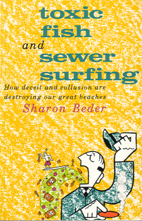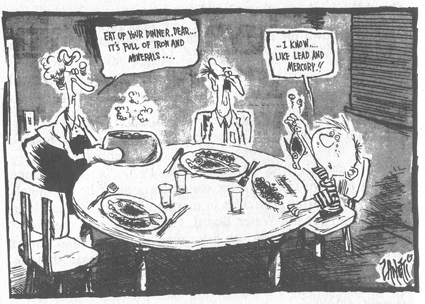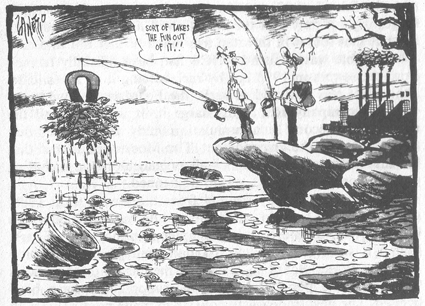
by Sharon Beder
first published by Allen & Unwin, Sydney, 1989
Introduction
Sewers seaward
Toothless watchdog
Toxic fish
Sewer-side surfing
Public relations battle
Events of 1989
Beyond Sydney
Conclusion
Bibliography
The cover-ups concerning fish contamination were given further exposure when ex-Water Board employee and marine biologist, Ron Snape, went public in early February. As mentioned in chapter 3, during the 1970s Snape had done tests on his own initiative for concentrations of heavy metals and organochlorine pesticides in marine life whilst undertaking a fish survey for the Water Board. He claimed that the Board told him to stop testing the fish, even though he had found very high levels of mercury in blackfish. Snape said that his report had subsequently been heavily rewritten and distorted and the information about heavy metals had been omitted (Herald, 4/2/89).
Snape’s story was also reported in the Telegraph and started of a new wave of concern about fish contamination. Various media outlets, including the Telegraph, obtained their own fish and had them sampled, inevitably finding various heavy metals in them. It was revealed that it was not only amateurs fishing of the rocks near the outfalls who were at risk. Apparently there was a thriving black market for fish caught at these spots. Time magazine interviewed a number of rock fishermen and reported that it was an open secret that these fish were sold to restaurants and fish-and-chip shops around Bondi and Sydney’s eastern suburbs (20/2/89). Within a few days of the Time article, but more than a year after the study results were available to the government, fishing within 500 metres of Sydney’s main outfalls was banned. The Minister for Agriculture, Mr Armstrong, was reported as saying that fishing in these areas constituted a grave danger (Herald, 24/2/89).

Cartoon by Paul Zanetti for the Daily Telegraph.
Many of the rock fishermen argued that they had been fishing at the outfalls for years and never become sick, but a woman whose husband had been a rock fisherman until reading the stories sent letters to a number officials to express her concern. She had eaten fish regularly before, during and after her pregnancy and her baby had been born with an extremely rare deformity of unknown cause. When I spoke to her she was adamant that she would not talk to the media about this and unsure whether her concerns were justified. But she was also extremely angry that she and her husband and the rest of the rock fishing community had not been warned of the dangers. In my discussions with high-level employees of the Water Board and the Hea1th Department about these dangers, they have merely expressed their contempt for people who are stupid enough to catch fish at sewage outfalls.

Cartoon by Paul Zanetti for the Daily Telegraph.
Not surprisingly, people stopped buying fish. By the beginning of March fish sales were reported to be down by 30 to 40 per cent and costing $500 000 a week in lost sales to the fishing industry. The Fish Marketing Authority was at pains to point out to people that most fish sold through them were from waters distant from the Sydney outfalls. Nick Greiner, Premier of New South Wales, tried to allay fears by publicly eating fish-kebabs at the fish markets. Yet the very next day a senior chemist at the Australian Analytical Laboratories, Ian Eckhard, was reported as saying that his laboratory had been testing fish for retailers at the markets for years and they regularly contained levels of mercury above the health limits set by the NH & MRC. Eckhard said it was a scandal, and those who lived on fish and chips would be accumulating mercury (Herald, 11/3/89).
By this time the pressure on the government to release the 1988 Bioaccumulation Study (see chapter 3) which covered Bondi and North Head as well as Malabar was immense and any hopes the government might have had that the issue would be forgotten were dashed. This second study also showed that fish were accumulating high levels of organochlorines, in particular chlordane and HCB, in amounts well above the health limits. The same fish also had mercury at levels exceeding the health limits. The fact that none of these heavily contaminated fish had been caught closer than 500 m from the outfall shows how ludicrous a 500 m fishing ban is. Also the fish were still contaminated 3.5 km from the outfalls, suggesting not only that the outfalls will not protect shoreline fish but that they will threaten fish much further out to sea.
Intractable wastes such as HCB had been officially banned from the sewers in 1988 but by reclassifying it as a pesticide, although it was not used as such, the Board was allowing the chemical company ICI to discharge it. It was not until the results of the second Bioaccumulation Study were released that the Minister for the Environment, Tim Moore, announced that the discharge to the sewers of all organochlorines, including organochlorine pesticides, would be banned.
Mercury was officially banned from the sewers until 1988, when the Board brought out its new trade waste policy which lifted the ban on mercury (see chapter 3). Yet in early March it was revealed that ICI had been given permission from the Water Board to discharge mercury into be sewers throughout the period when it was supposed to have been banned. The new trade waste policy had made no difference to them. When confronted with this the Board’s acting trade waste manager said, ‘You have to be flexible. Some people have an effluent problem which cannot meet [standards in] a document’ (Herald, 9/3/89). One wonders how effective the ban on organochlorines will be in the light of these comments. ICI was still discharging HCB several months after the Minister announced the ban on them.
Various government authorities in New South Wales still deny that mercury contamination of fish is a problem of Sydney. Various senior people whom I have spoken to from the Health Department, the Water Board and the Fisheries Research Institute argue that the NH & MRC limits are not health limits. They argue that since these limits have safety factors built into them, they don’t represent a level at which health is threatened. They say that you would have to eat a 1ot of contaminated fish every day before you became sick. But it has been estimated by the NH & MRC that an ‘average’ person of 70 kilograms can consume 0.3 mg of mercury each day and just be on the borderline of showing clinical symptoms of toxicity. It is assumed that such a person would eat no more than 410 grams of fish per week. The resultant NH & MRC maximum residue level incorporates a safety factor of ten to ensure protection for lighter people and children, people who eat more than this amount of fish and people who are more sensitive than normal, as well as to allow or uncertainties, particularly with regard to long-term consequences such as cancers and mutagenic effects about which little is known.
Despite this, organisations like the Fish Merchants’ Association have been lobbying to have the NH & MRC limits doubled because they say that the waters of Sydney are naturally high in mercury concentration and that fish high in mercury may not be contaminated from the sewage outfalls. They argue that the limits should be raised so that fish with naturally high levels of mercury can still be caught, sold and consumed. The Fisheries Research Institute also argues that although tonnes of mercury are discharged through the outfalls each year high levels of mercury in fish probably come from natural background concentrations and therefore NH & MRC limits should not, they say, be regarded as health limits. (This is a bit like an engineer designing a bridge with safety factors to allow for uncertainties, and then arguing that because one of the major stresses on the bridge is natural, like wind, and because they have used safety factors, the maximum design load should be doubled.)